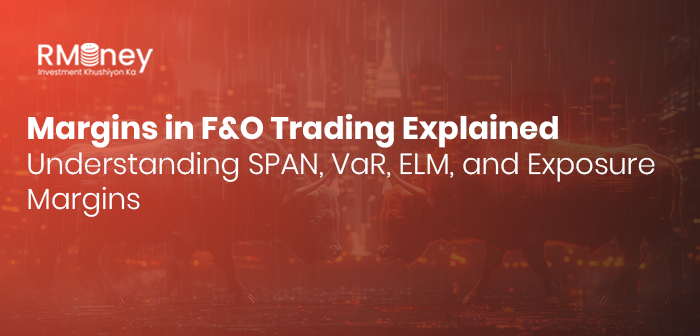Margins in F&O Trading Explained: Understanding SPAN, VaR, ELM, and Exposure Margins
Post Date : October 27, 2025

In India’s Futures and Options (F&O) segment, margins are collected upfront to safeguard both traders and the market from potential losses. These margins ensure that participants always have enough capital to cover risks arising from price fluctuations.
In practical terms, the Initial Margin is made up of multiple components SPAN (Portfolio Risk Margin), Value at Risk (VaR), Extreme Loss Margin (ELM), and Exposure or Event-Day Add-ons specified by the exchange. Understanding how these components work together helps traders stay compliant while optimizing their capital usage.
Understanding SPAN, VaR, and ELM
1. SPAN (Portfolio Risk Margin)
SPAN, short for Standard Portfolio Analysis of Risk, is the exchange’s risk engine that simulates various market scenarios to estimate the worst possible one-day loss for a trader’s combined futures and options portfolio.
Since risk is calculated at the portfolio level, hedged or offsetting positions (like spreads) often reduce the total margin requirement — making SPAN a risk-based and capital-efficient system.
2. VaR (Value at Risk)
VaR measures the expected daily price movement risk based on market volatility. It represents the likely loss that could occur under normal trading conditions.
3. ELM (Extreme Loss Margin)
ELM acts as an additional safety buffer to cover rare and extreme market events that might not be captured by VaR. It helps maintain market stability during sudden shocks or black-swan events.
Note: Brokers are required to collect these upfront margins before trade execution. Any shortfall can attract penalties or lead to a reduction in positions.
What is Exposure or Add-on Margin?
The Exposure Margin (also called Add-on Margin) is an extra cushion collected over and above SPAN, VaR, and ELM. It is meant to protect the system from residual, tail-end, or model risks — particularly during periods of high volatility, corporate actions, or expiry sessions.
These rates are determined by the exchange and can change based on market conditions.
Avoid assuming fixed rates like 2% or 3% always check your broker’s live margin calculator or the latest exchange circulars for updated values.
Initial Margin = Total Upfront Requirement
The total margin blocked before entering a trade includes:
- SPAN (Portfolio Risk Margin)
- VaR (Value at Risk)
- ELM (Extreme Loss Margin)
- Exchange-mandated Exposure/Add-on Margins
This margin is calculated on a net portfolio basis, taking into account all open positions.
Hedged or defined-risk strategies typically require lower margins, as the maximum loss is capped, unlike naked positions where the potential loss is unlimited.
Why Margins Matter?
- Risk Management: Margins ensure traders have adequate funds to absorb market volatility.
- Market Stability: Proper margining helps prevent excessive leverage and disorderly price movements.
- Regulatory Compliance: Margin shortfalls can lead to penalties or forced position closures by the broker or exchange.
Recent Updates
- Dynamic Buffers: Exchanges may impose higher add-ons during volatile periods, around major events, or near expiry. Spread benefits may also be reduced in such times.
- Premium and Offsets: Option buyers pay premiums upfront, while sellers must maintain full margins. Hedged strategies remain more margin-efficient, but expiry-day treatment may vary by product.
- Live Monitoring: Since margins change dynamically, traders should always verify current requirements through their broker’s calculator and refer to the latest circulars before taking positions.
Key Takeaways
- “SPAN” is often used as a general term for portfolio risk margin, but Initial Margin also includes VaR, ELM, and exposure add-ons.
- Exposure margins are not fixed; they vary across instruments and market conditions.
- Hedged positions significantly reduce margin requirements compared to naked positions.
- Always maintain sufficient balance to avoid penalties or auto square-offs.
Remember
- Use a live margin calculator before placing any order to estimate the exact requirement.
- Recheck margin requirements on expiry days or ahead of key events for possible changes.
- Stay updated with exchange and broker circulars, as margin norms are revised periodically.

Stock Trading Now trade in ₹9 Per Order or ₹ 999 Per Month Plans.
Future & Options Access F&O contracts with advanced tools for hedging and speculation.
Currency Trading Trade in major currency pairs and manage forex exposure efficiently.
Commodity Trading Diversify Trading with MCX & NCDEX by Trading in Gold, Silver, Base Metals, Energy, and Agri Products.
Margin Trading Funding Boost your buying power with upto 5X, Buy now Pay Later
Algo Trading Back test, Paper Trade your logic & Automate your strategies with low-latency APIs.
Trading View Leverage Trading View charts and indicators integrated into your trading platform.
Advanced Options Trading Execute multi-leg option strategies with precision and insights.
Stock Lending & Borrowing Earn passive income by lending stocks securely through SLB.
Foreign Portfolio Investment Enable NRIs and FPIs to invest in Indian markets with ease and compliance.
IPO Invest in upcoming IPOs online with real-time tracking and instant allotment updates.
Direct Mutual Funds 0% Commissions by investing in more than +3500 Direct Mutual Fund Scheme.
Corporate FDRs Earn fixed returns with low-risk investments in high-rated corporate fixed deposits.
Stocks SIPs Build long-term wealth with systematic investment plans in top-performing stocks.
Bonds & NCDs Access secure, fixed-income investments through government and corporate bond offerings.
Depository Services Safely hold and manage your securities with seamless Demat and DP services with CDSL.
Journey Tracing our growth and milestones over time.
Mission & Vision Guided by purpose, driven by long-term vision.
Why RMoney Platform Smart, reliable platform for all investors' needs.
Management Experienced leadership driving strategic financial excellence.
Credentials Certified expertise with trusted industry recognition.
Press Release Latest company news, updates, and announcements.
Testimonials Real client stories sharing their success journeys.
7 Reasons to Invest Top benefits that make investing with us smart.
SEBI Registered Research Trusted insights backed by SEBI-compliant research.
Our Technology Advanced tools enabling efficient online trading.
Calculators Access a suite of smart tools to plan trades, margins, and returns effectively.
Margin Calculator Instantly check margin requirements for intraday and delivery trades.
MTF Calculator Calculate MTF funding cost upfront to ensure full transparency before placing a trade.
Brokerage Calculator Know your exact brokerage charges before placing any trade.
Market Place Explore curated investment products and trading tools in one convenient hub.
RMoney Gyan Enhance your market knowledge with expert blogs, videos, and tutorials.
Performance Tracker Track our research performance with full transparency using our performance tracker.
Feedback Share your suggestions or concerns to help us improve your experience.
Downloads Access important forms, software, and documents in one place.
Locate Us Find the nearest RMoney branch or service center quickly.
Escalation Matrix Resolve issues faster with our structured support escalation process.
Back Office Log in to view trade reports, ledger, and portfolio statements anytime.
Account Modification Update personal or bank details linked to your trading account.
Fund Transfer Transfer funds instantly online with quick limit updation to your trading account.
Bank Details View our registered bank account details for seamless transactions by NEFT, RTGS or IMPS.
How to Apply IPO Step-by-step guide to apply for IPOs using your trading account.
RMoney Quick Mobile App Trade on-the-go with our all-in-one mobile trading app.
RMoney Quick login Quickly access your trading account through the RMoney Quick web-based trading.
RMoney Rocket Web Version Experience powerful web-based trading with advanced tools for algo traders.
RMoney Rocket Mobile Version Trade anytime, anywhere with our feature-rich mobile trading platform.












